Visualizing Success: Choosing the Right Architecture Tool
Clear software architecture diagrams are essential for effective communication and efficient development. Choosing the right software architecture visualization tool can be challenging given the many options. This listicle examines eight leading tools—Structurizr, PlantUML, Lucidchart, Visual Paradigm, Enterprise Architect, draw.io (diagrams.net), Mermaid JS, and Software Ideas Modeler—to simplify your decision-making process. We'll highlight key features, pros, and cons for each, helping you select the best fit for your project, whether a small application or a large enterprise system. These tools solve the problem of complex system representation by providing clear visuals to aid collaboration and prevent misunderstandings.
1. Structurizr
Structurizr stands out among software architecture visualization tools by enabling developers to create diagrams as code, ensuring that visualizations stay synchronized with the actual system implementation. Leveraging the C4 model, it provides a structured approach to visualizing software architecture from high-level context diagrams down to low-level code components. This approach promotes consistency and clarity, particularly valuable for complex projects and distributed teams. Unlike traditional drag-and-drop tools, Structurizr uses a lightweight Domain Specific Language (DSL) to define the architecture model, allowing diagrams to be generated programmatically. This means the architecture model can be version-controlled alongside the codebase, making it easier to track changes and maintain accurate documentation. This approach is particularly beneficial for teams aiming to adhere to code-structure best practices and ensure that documentation evolves with the system.
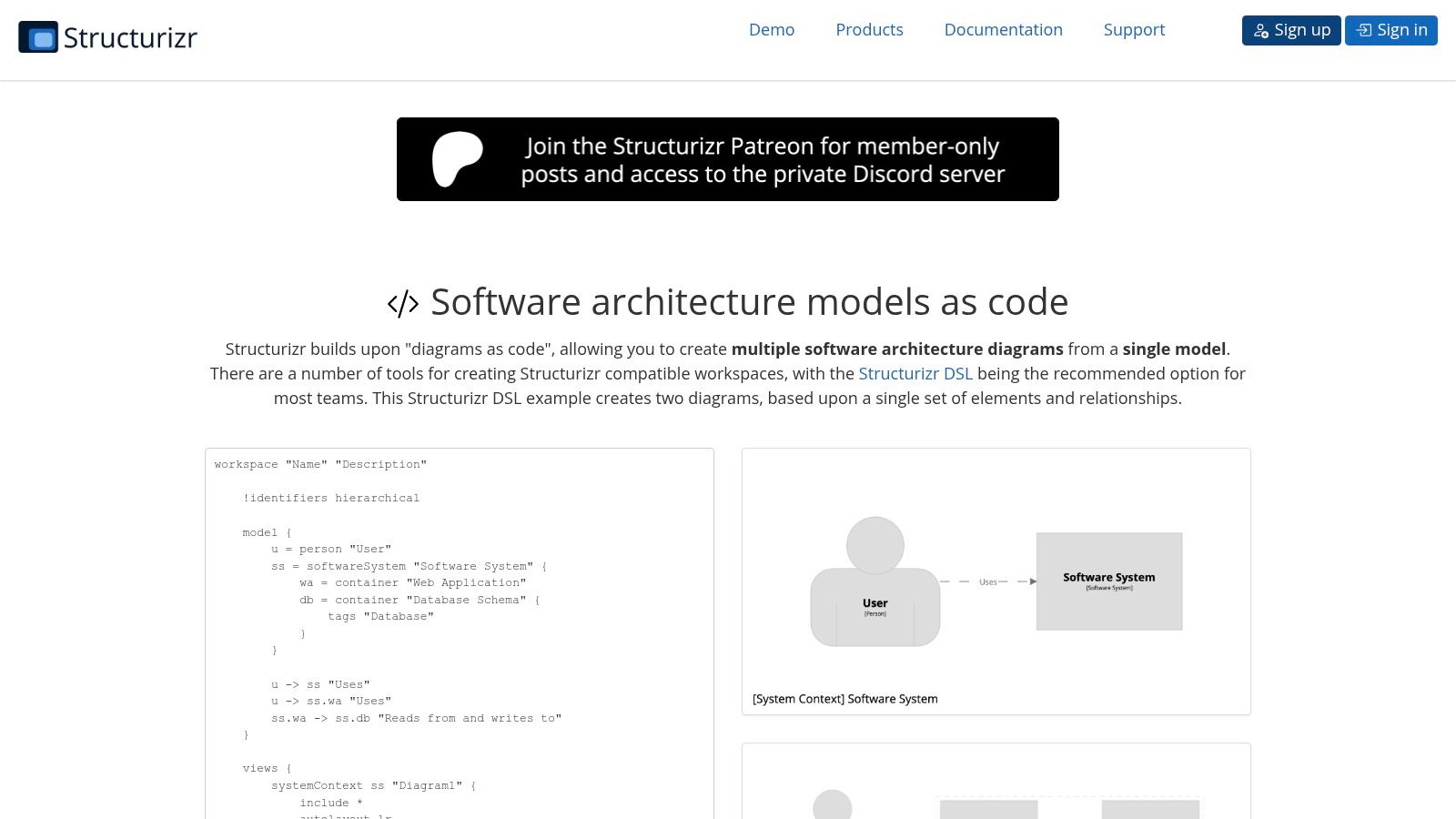
One of Structurizr’s key advantages is its support for multiple views derived from a single model. This allows architects to tailor the level of detail presented to different audiences. For instance, a high-level context diagram can be shown to business stakeholders, while developers can dive into component diagrams focusing on specific services. Structurizr offers client libraries for various programming languages, including Java, .NET, PHP, and JavaScript, giving developers flexibility in integrating it into their existing workflows. Learn more about Structurizr and how it can improve code structure and maintainability.
Structurizr offers both a cloud-based service and an on-premise enterprise edition. The cloud-based option provides a free tier for open-source projects and small teams, while larger organizations requiring private hosting and additional features can opt for the enterprise version. Pricing for the enterprise version varies based on the number of users and workspaces required. For specific pricing details, it's recommended to contact Structurizr directly.
Features:
- Based on the C4 model (Context, Containers, Components, Code)
- Provides both code-based and (limited) UI-based diagram creation
- Supports multiple views of the same architecture model
- Lightweight DSL for defining architecture models
- Enterprise version available for self-hosting
- Integrations with various platforms and tools
Pros:
- Diagrams remain in sync with code as they're generated from the same source
- Encourages a consistent architectural representation across teams
- Highly flexible with multiple language bindings (Java, .NET, PHP, etc.)
- Free tier available for basic usage
Cons:
- Steeper learning curve compared to drag-and-drop software architecture visualization tools
- Enterprise features require paid licensing
- Limited styling options compared to dedicated drawing tools
- Some users find the DSL syntax restrictive
Website: https://structurizr.com/
Structurizr is a powerful tool for software architects and developers seeking a code-centric approach to architecture visualization. While the DSL may require some initial investment to learn, the benefits of automated diagram generation and consistent documentation make it a valuable addition to any project striving for high-quality software architecture. This especially holds true for projects using Agile methodologies and DevOps practices, where maintaining accurate and up-to-date documentation is crucial. Its focus on keeping diagrams in sync with the code makes Structurizr a compelling choice for teams working on evolving and complex systems.
2. PlantUML
PlantUML stands out among software architecture visualization tools due to its unique text-based approach to UML diagramming. Instead of dragging and dropping shapes on a canvas, you describe your diagrams using a simple and intuitive language. This makes PlantUML exceptionally versatile and well-suited for collaborative projects, especially for developers who prefer working with text. This approach also makes it incredibly easy to manage diagrams within version control systems like Git, treating them as any other source code file. This facilitates collaboration, tracks changes effectively, and simplifies the process of rolling back to previous versions. For teams building complex software systems, having diagrams tightly integrated with their codebase is a significant advantage.
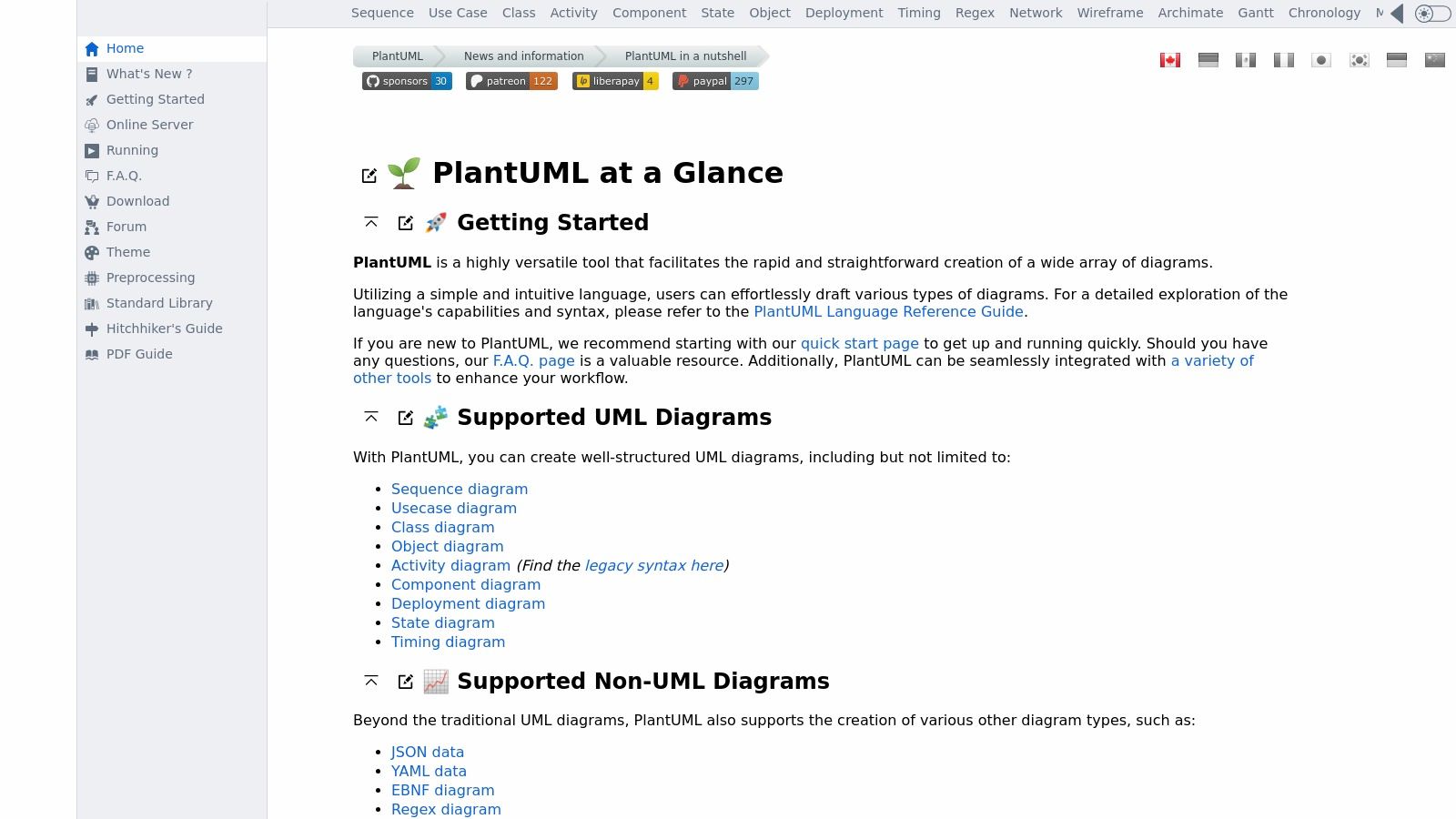
PlantUML supports a wide range of UML diagram types, catering to diverse software architecture visualization needs. From sequence diagrams that illustrate the flow of interactions within a system to use case diagrams that capture user requirements, class diagrams for modeling object-oriented designs, and component diagrams for representing system architecture, PlantUML offers a comprehensive toolkit. This breadth of coverage makes it applicable across various stages of the software development lifecycle, from initial design and planning to documentation and maintenance. Furthermore, its extensive integration with popular IDEs, wikis (like Confluence), and documentation generators (like Doxygen) streamlines the workflow, allowing developers to seamlessly incorporate diagrams into their existing tools. For example, you can embed PlantUML code directly into your code comments or documentation files, generating diagrams automatically during builds.
PlantUML's open-source nature, coupled with its robust community support and a rich ecosystem of plugins, contributes significantly to its appeal. Being free to use eliminates licensing costs and fosters community-driven development, ensuring ongoing improvements and extensions. The extensive documentation and readily available examples provide a gentle learning curve for newcomers, while the active community offers a platform for troubleshooting and sharing best practices.
Features:
- Text-based UML diagram creation
- Supports numerous UML diagram types (sequence, component, class, use case, activity, state, object, deployment, timing diagrams, etc.)
- Wide integration with IDEs, documentation tools, and wikis
- Version control friendly (diagrams are stored as text)
- Can be used online or offline
Pros:
- Free and open-source
- Easily version controlled as plain text
- Extensive documentation and examples
- Strong community support and plugins
Cons:
- Limited customization for complex visual styling (compared to dedicated graphical tools)
- Can be verbose for complex diagrams
- Initial learning curve for the syntax
- Rendering can be slow for very large diagrams
Website: https://plantuml.com/
PlantUML’s text-based approach makes it a powerful and flexible tool for software architecture visualization. Its strengths lie in its simplicity, version control friendliness, and wide integration capabilities. While graphical tools might offer more advanced styling options, PlantUML's ease of use, collaborative features, and open-source nature make it a valuable asset for any development team. This is especially true for teams prioritizing maintainability and collaboration in their diagramming workflows.
3. Lucidchart
Lucidchart is a versatile, cloud-based diagramming software well-suited for visualizing software architecture, among other uses. It provides a robust platform for creating various diagrams, from simple UML diagrams to complex system architectures, making it a valuable tool for software developers, AI/ML practitioners, DevOps engineers, data scientists, and technical project managers. Its collaborative features facilitate real-time teamwork, and integrations with popular platforms like Google Workspace, Microsoft Office, and Atlassian products streamline workflows. This breadth of functionality earns Lucidchart a deserved spot on this list of top software architecture visualization tools.
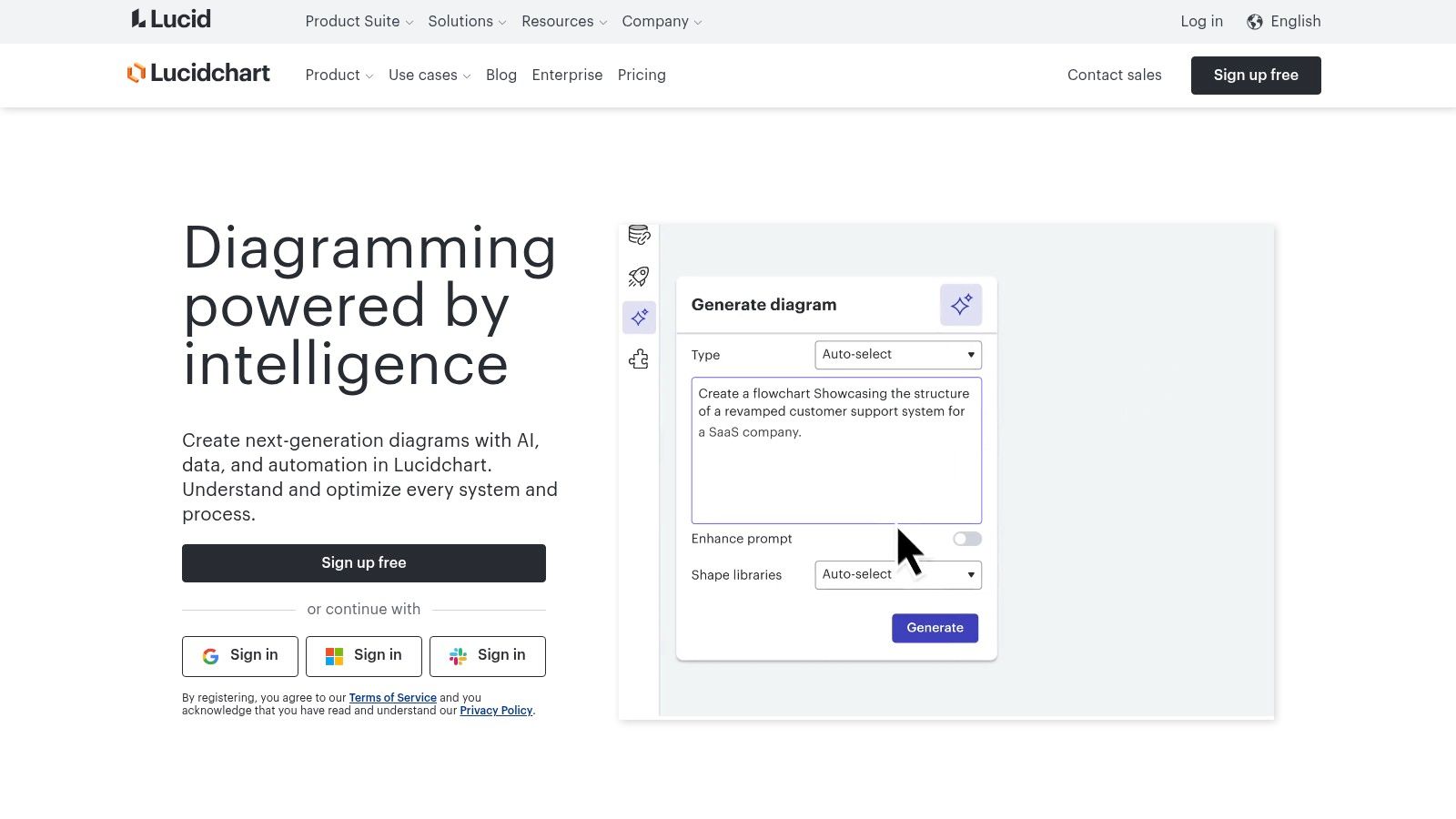
Lucidchart simplifies the process of creating software architecture diagrams with its intuitive drag-and-drop interface and extensive shape libraries tailored for various architectural styles (e.g., microservices, layered architectures, event-driven architectures). Teams can collaborate on diagrams simultaneously, making real-time design discussions and feedback implementation much more efficient. The integration with tools like Jira and Confluence allows for seamless embedding of diagrams within project documentation and issue tracking systems. Features like presentation mode and commenting further enhance collaboration and communication around the visualized architecture. While exploring various architecture options and the challenges they bring, like those discussed in this article: Learn more about Lucidchart, Lucidchart can be invaluable for collaborative visualization and problem-solving.
While Lucidchart excels in its user-friendliness and collaborative features, it's important to be aware of its limitations. Its general-purpose nature, while offering versatility, means it's not solely focused on software architecture visualization. As a result, features like code-to-diagram automation are less developed compared to more specialized tools. Performance can also be a concern when working with highly complex diagrams. Finally, the subscription-based pricing model can be expensive, particularly for individual users.
Features:
- Real-time collaboration with multiple users
- Extensive shape libraries for software architecture
- Integrations with Jira, Confluence, Google Drive, Microsoft Office, and more
- Presentation mode and commenting features
- Enterprise security and compliance features
Pros:
- Intuitive drag-and-drop interface
- Excellent real-time collaboration capabilities
- Comprehensive templates for various architecture needs
- Cross-platform compatibility (web-based)
Cons:
- Subscription-based pricing can be costly
- Not specialized for software architecture
- Limited code-to-diagram automation
- Potential performance issues with complex diagrams
Website: https://www.lucidchart.com/
Lucidchart is a powerful tool for teams looking for a collaborative platform for visualizing software architecture. Its ease of use, extensive integrations, and comprehensive features make it a strong contender, particularly for organizations already invested in the connected ecosystem of tools. However, individuals or teams specifically requiring advanced code generation or specialized architecture visualization features might consider exploring alternative, more niche solutions.
4. Visual Paradigm
Visual Paradigm is a robust, all-in-one software architecture visualization tool geared towards professional software development teams. It offers a comprehensive suite of features, covering everything from UML and SysML diagrams to ERD, DFD, and even organization charts, making it a powerful choice for visualizing complex systems. Its strength lies in its ability to bridge the gap between design and implementation through round-trip engineering, allowing synchronization between code and diagrams. This allows developers to visualize existing codebases, generate code from diagrams, and ensure consistency throughout the software development lifecycle. This makes it particularly valuable for teams working on large-scale projects requiring detailed and up-to-date documentation.
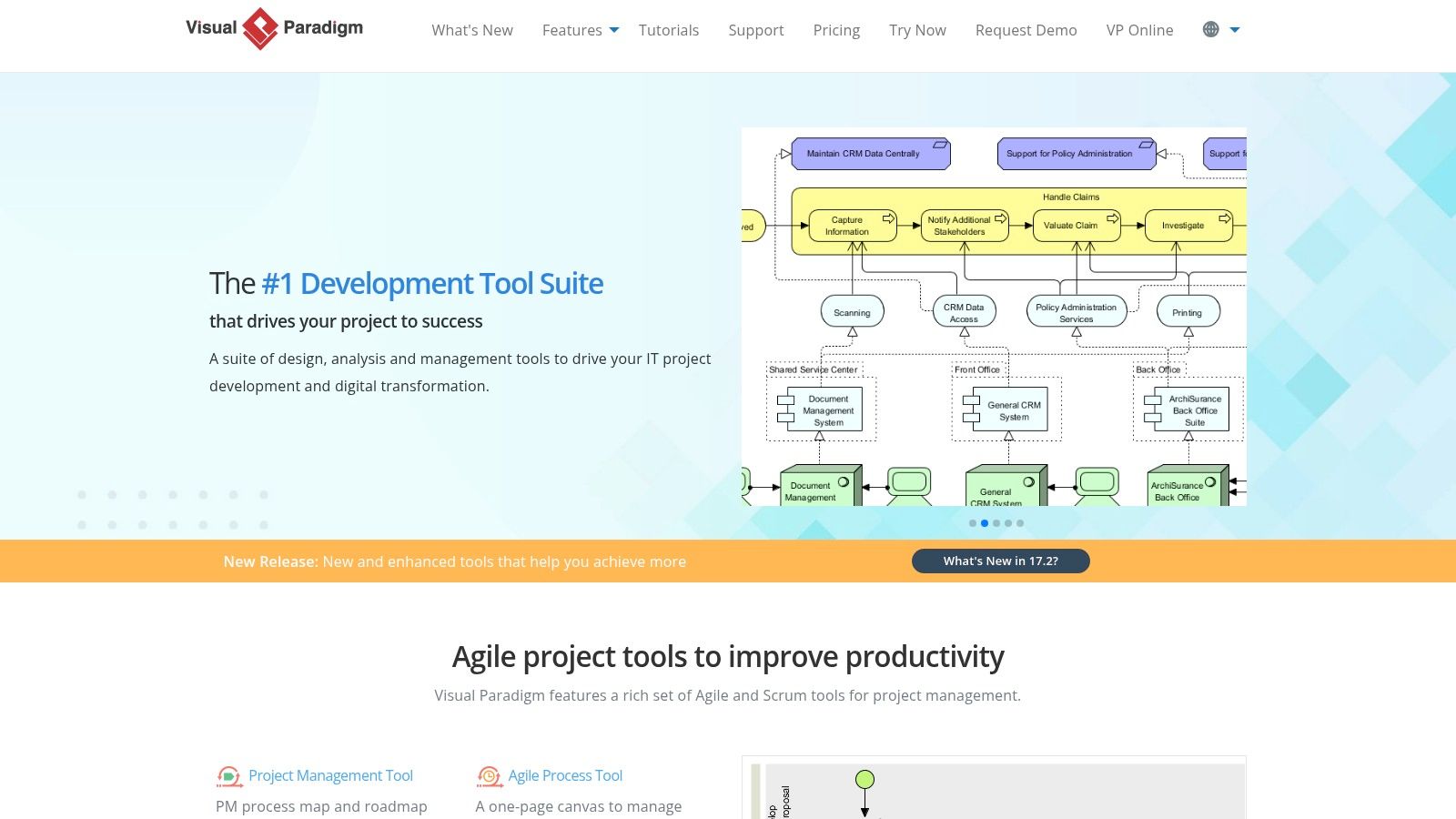
Visual Paradigm excels in facilitating a model-driven approach to software development. For example, architects can create detailed UML diagrams depicting the system's structure and behavior, while developers can use these diagrams to generate code stubs and ensure their implementation aligns with the design. Its support for SysML also makes it suitable for systems engineering projects, enabling the modeling of complex systems with hardware and software components. Furthermore, the integration with popular IDEs like Eclipse, IntelliJ IDEA, and Visual Studio streamlines the development workflow, enabling developers to access visualization and modeling capabilities directly within their preferred development environment. This tight integration minimizes context switching and improves developer productivity.
Visual Paradigm also offers robust features for team collaboration, including version control, which is essential for managing changes and maintaining consistency in collaborative projects. Its report generation capability, based on customizable templates, simplifies the creation of professional documentation. This is particularly useful for communicating architectural decisions and design details to stakeholders.
While Visual Paradigm offers a wealth of features beneficial for large projects and enterprise teams, its comprehensiveness contributes to a steeper learning curve compared to simpler software architecture visualization tools. The extensive feature set can make the interface feel cluttered, especially for users new to the tool. The traditional desktop application UX may also feel less modern compared to some cloud-based alternatives. Additionally, Visual Paradigm sits at a higher price point than many other tools on the market. While several licensing options are available, ranging from individual licenses to enterprise editions, the cost might be a barrier for smaller teams or individual developers.
Key Features and Benefits:
- Comprehensive Diagram Support: Supports a wide range of diagrams, including UML, SysML, ERD, DFD, and more.
- Code Engineering: Enables both code generation and reverse engineering, promoting synchronization between models and code.
- IDE Integration: Seamlessly integrates with popular IDEs such as Eclipse, IntelliJ IDEA, and Visual Studio.
- Team Collaboration: Provides version control and collaboration features for effective teamwork.
- Report Generation: Simplifies the creation of professional reports based on customizable templates.
Pros:
- All-in-one solution for design, development, and management
- Extensive diagram types and notations supported
- Strong code-model synchronization capabilities
- Scalable from individual developers to large enterprises
Cons:
- Higher price point
- Steep learning curve
- Cluttered interface (potentially overwhelming for new users)
- Traditional desktop application feel
Website: https://www.visual-paradigm.com/
Visual Paradigm earns its place on this list due to its comprehensive features and powerful code engineering capabilities. It is a strong choice for larger teams and complex projects requiring rigorous modeling and documentation. However, smaller teams or individuals might find its complexity and cost a deterrent, making it essential to weigh these factors against the tool's extensive feature set when considering it as a software architecture visualization solution.
5. Enterprise Architect
Sparx Systems Enterprise Architect is a powerful software architecture visualization tool designed for comprehensive modeling and design throughout the entire software development lifecycle. Its extensive capabilities make it particularly well-suited for visualizing and managing large-scale, complex enterprise architectures. Beyond simple diagramming, Enterprise Architect provides robust support for various modeling languages, including UML, BPMN, SysML, and ArchiMate, covering everything from software design and business processes to systems engineering and enterprise architecture frameworks. This breadth of coverage positions it as a versatile solution for diverse teams and projects within an organization. If you're dealing with intricate systems and require a tool to help manage complexity, Enterprise Architect is worth serious consideration.
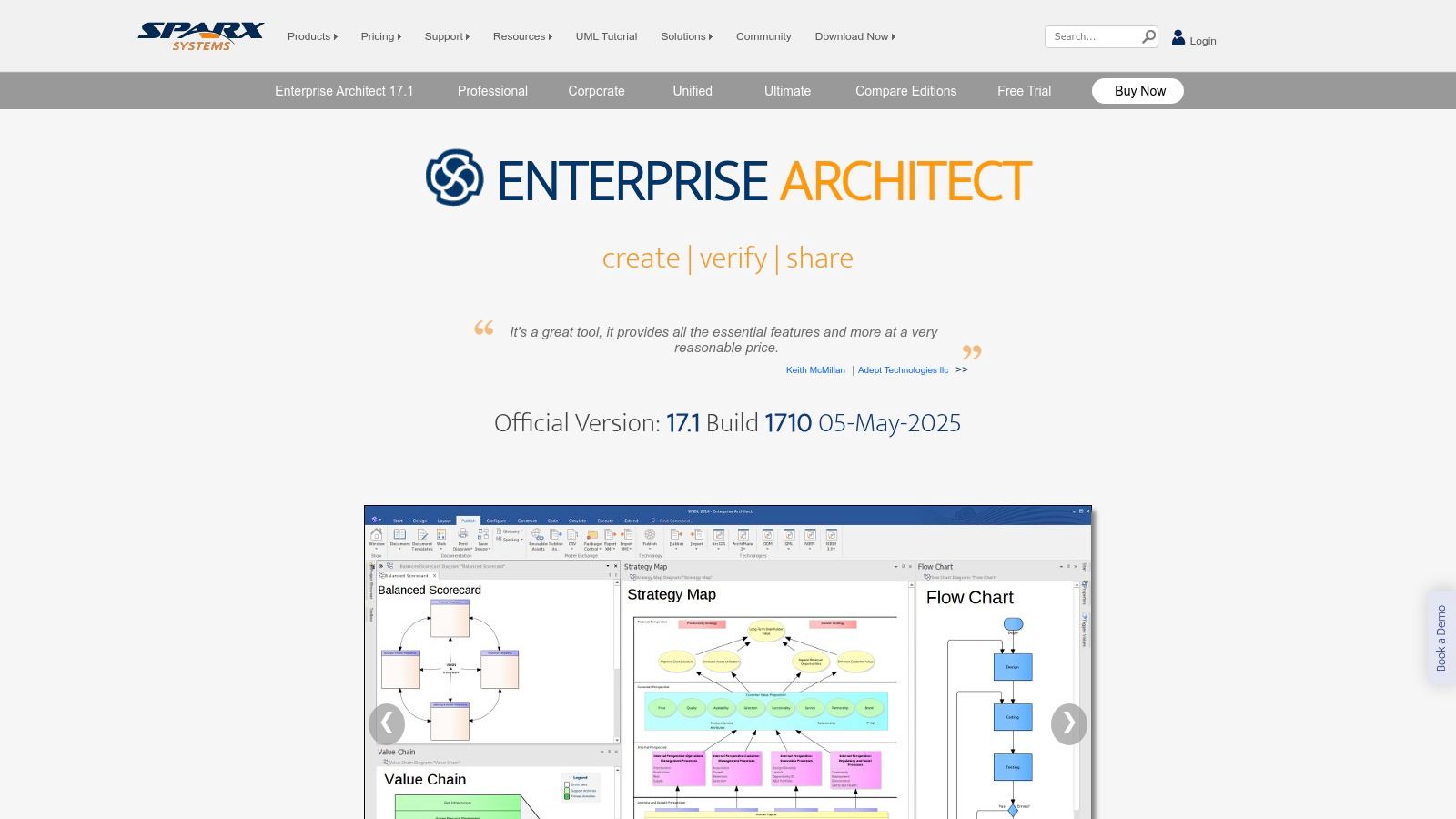
Enterprise Architect’s strength lies in its ability to connect different aspects of software development. For example, software developers can use it to generate code from UML diagrams, facilitating a seamless transition from design to implementation. DevOps engineers benefit from the tool's ability to model infrastructure and deployments, aiding in automation and infrastructure-as-code initiatives. Technical project managers can leverage the project management and requirements management features to track progress, manage resources, and ensure alignment between technical deliverables and business objectives. Data scientists and AI/ML practitioners can also utilize Enterprise Architect to model data flows, system integrations, and complex algorithms, improving communication and understanding among team members. Learn more about Enterprise Architect for a deeper dive into its code analysis benefits. This integration of various functionalities into a single platform facilitates traceability, reduces inconsistencies, and fosters better collaboration among different stakeholders.
Features:
- Comprehensive Modeling Standards Support: UML, BPMN, SysML, ArchiMate, and more.
- Code Engineering: Code generation, reverse engineering, and synchronization.
- Documentation & Reporting: Generate detailed documentation and reports directly from models.
- Team Collaboration & Version Control: Supports collaborative modeling and version control for team projects.
- Simulation & Execution: Simulate and execute models to validate design and behavior.
Pros:
- Comprehensive Feature Set: A rich set of features makes it suitable for virtually any enterprise architecture need.
- Strong Traceability: Easily trace relationships between different architectural elements.
- Scalability: Handles large, complex systems and models effectively.
- Industry Standards Compliance: Strong support for widely adopted industry standards and methodologies.
Cons:
- Steep Learning Curve: The extensive feature set can be overwhelming for new users.
- Dated UI: The user interface might feel dated compared to some modern alternatives.
- Higher Cost: It comes at a higher price point than some simpler, more specialized tools.
- Resource Intensive: Can consume significant system resources, especially with large models.
Website: https://sparxsystems.com/products/ea/
Pricing: Varies based on edition (Professional, Corporate, Unified) and user licenses; a free trial is available.
Technical Requirements: Windows OS primarily supported (limited macOS/Linux compatibility via Wine/CrossOver). Specific hardware requirements depend on model complexity.
Enterprise Architect distinguishes itself from lighter-weight software architecture visualization tools by offering a deeply integrated and comprehensive platform for managing the entire software development lifecycle, particularly in complex enterprise settings. While tools like draw.io or PlantUML might be sufficient for simpler diagrams, Enterprise Architect goes beyond visualization to offer powerful features for modeling, simulation, code engineering, and project management, all within a single unified environment. This makes it an ideal choice for organizations looking for a robust solution to manage the complexity of their software architecture and its related processes.
6. draw.io (diagrams.net)
draw.io, now known as diagrams.net, secures its spot on this list of top software architecture visualization tools thanks to its accessibility, flexibility, and open-source nature. It's a robust diagramming tool available both online and as a desktop application, catering to a variety of visualization needs, from simple flowcharts to complex software architecture diagrams. Whether you're mapping out UML diagrams, entity-relationship diagrams, network diagrams, or sketching initial design concepts, draw.io offers a comprehensive suite of tools to get the job done. Its integration with popular cloud storage platforms like Google Drive, OneDrive, and GitHub further enhances its appeal, simplifying collaboration and version control for teams.

One of the most significant advantages of draw.io is that it's entirely free and open-source, with no limitations on features. This removes the cost barrier associated with many other diagramming tools, making it an attractive option for individuals, startups, and larger organizations alike. The online version eliminates the need for installation, allowing you to start diagramming immediately from any device with a web browser. The interface is intuitive and user-friendly, featuring drag-and-drop functionality for effortless creation and manipulation of diagram elements. For teams using GitHub, draw.io becomes even more powerful, offering seamless integration for version control of your diagrams alongside your code.
For software developers, draw.io offers a practical way to visualize system architecture, component interactions, and data flows. DevOps engineers can leverage it for infrastructure diagrams and deployment pipelines. AI/ML practitioners can use it to illustrate model architectures and data pipelines. Data scientists can create entity-relationship diagrams for database design and visualize complex data relationships. Technical project managers can utilize draw.io for high-level system overviews and project planning diagrams.
Features:
- Free and open-source with no feature restrictions
- Available online and as a desktop application
- Extensive library of shapes and templates for software architecture diagrams (UML, ERD, network diagrams, etc.)
- Integration with cloud storage (Google Drive, Dropbox, OneDrive, GitHub)
- Export to various formats (PNG, PDF, SVG, HTML)
Pros:
- No cost barrier (completely free)
- Available online without installation
- Simple, intuitive interface with drag-and-drop functionality
- Version control friendly when integrated with platforms like GitHub
Cons:
- Real-time collaboration features are less advanced than dedicated collaboration tools.
- Lacks automated diagram generation from code, requiring manual creation and updates.
- Fewer specialized software architecture features compared to dedicated tools like Structurizr.
- Basic styling capabilities compared to professional diagramming software.
Website: https://www.diagrams.net/
While draw.io may not offer the advanced features of specialized commercial software architecture visualization tools, its ease of use, accessibility, and zero cost make it an excellent choice for a wide range of users. It’s a powerful and versatile tool that deserves a place in any software developer’s toolkit. For quick visualizations, brainstorming sessions, and collaborative design, draw.io offers an efficient and cost-effective solution. If your needs are more specialized, consider exploring dedicated software architecture tools, but for general-purpose diagramming, draw.io is an excellent starting point.
7. Mermaid JS
Mermaid JS is a powerful JavaScript-based diagramming and charting tool that earns its spot on this list of software architecture visualization tools because it allows developers to create and modify diagrams dynamically using a simple, Markdown-inspired text definition language. This text-based approach is particularly appealing to developers who prefer working with code over visual drag-and-drop interfaces. This makes it incredibly version control friendly, fitting seamlessly into existing development workflows. Imagine checking in your architecture diagrams alongside your code – that's the power of Mermaid JS.
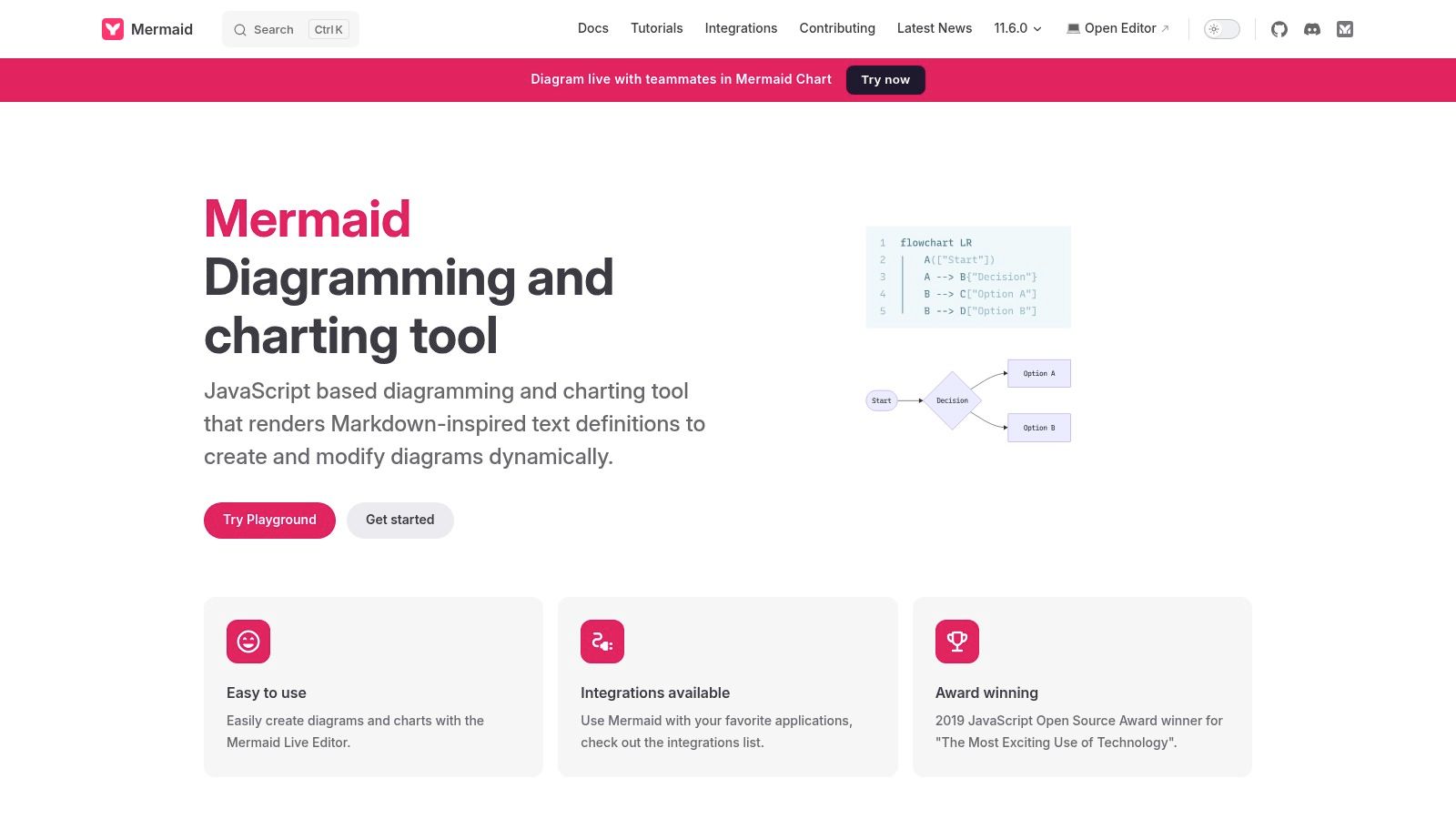
Mermaid JS supports a variety of diagram types crucial for visualizing software architecture, including flowcharts, sequence diagrams, class diagrams, state diagrams, and more. This flexibility makes it suitable for a wide range of use cases. For example, DevOps engineers can use it to map out deployment pipelines, while software developers can visualize complex class interactions or system flows. Technical project managers can also leverage Mermaid JS to communicate project architecture to stakeholders in a clear and concise manner. Its seamless integration with documentation tools, wikis, and Markdown editors makes it a perfect choice for keeping documentation up-to-date and easily accessible.
A key advantage of using Mermaid JS is its open-source nature and free availability. It’s lightweight and doesn't require specialized software, making it easy to integrate into any development environment. The growing ecosystem of plugins for popular platforms further enhances its utility. Compared to visual editors, Mermaid JS offers a more developer-centric approach, allowing for greater control and reproducibility of diagrams. For teams already comfortable with Markdown, the learning curve is minimal.
However, Mermaid JS does have some limitations. Its advanced styling capabilities are somewhat restricted compared to dedicated diagramming tools. Non-technical users might find the text-based approach less intuitive than a visual editor. While it handles most diagrams with ease, very complex diagrams can sometimes present rendering challenges. Finally, compared to specialized tools, the range of diagram types offered is slightly smaller.
Key Features & Benefits:
- Text-based Diagram Definition: Use a simple, Markdown-like syntax to define diagrams.
- Dynamic Rendering: Diagrams are rendered directly in the browser.
- Multiple Diagram Types: Supports flowcharts, sequence diagrams, class diagrams, state diagrams, and more.
- Easy Integration: Seamlessly integrates with documentation tools, wikis, and Markdown editors.
- Open-Source and Free: No licensing costs and readily available.
Pros:
- Free and open-source
- Version control friendly
- Easy integration with development workflows
- Lightweight
Cons:
- Limited advanced styling
- Less intuitive for non-technical users
- Potential rendering issues with complex diagrams
- Fewer diagram types than some specialized tools
Website: https://mermaid.js.org/
Mermaid JS is an excellent choice for developers seeking a code-driven, lightweight, and easily integrable solution for software architecture visualization. Its Markdown-like syntax makes it a natural fit for developer workflows and documentation, making it a valuable addition to any software development toolkit.
8. Software Ideas Modeler
Software Ideas Modeler is a comprehensive modeling and diagramming tool specifically designed for software architecture visualization. This robust tool caters to a broad range of software design needs, making it a valuable asset for visualizing complex systems. Its support for over 30 diagram types, including all UML diagrams, Entity-Relationship Diagrams (ERD), Data Flow Diagrams (DFD), Business Process Model and Notation (BPMN), and more, ensures that you can effectively model every aspect of your software architecture. Whether you are designing a new application, documenting an existing system, or communicating architectural designs to stakeholders, Software Ideas Modeler provides the necessary tools. This versatility makes it an excellent choice for software developers, AI/ML practitioners, DevOps engineers, data scientists, and technical project managers seeking a powerful yet accessible software architecture visualization tool.
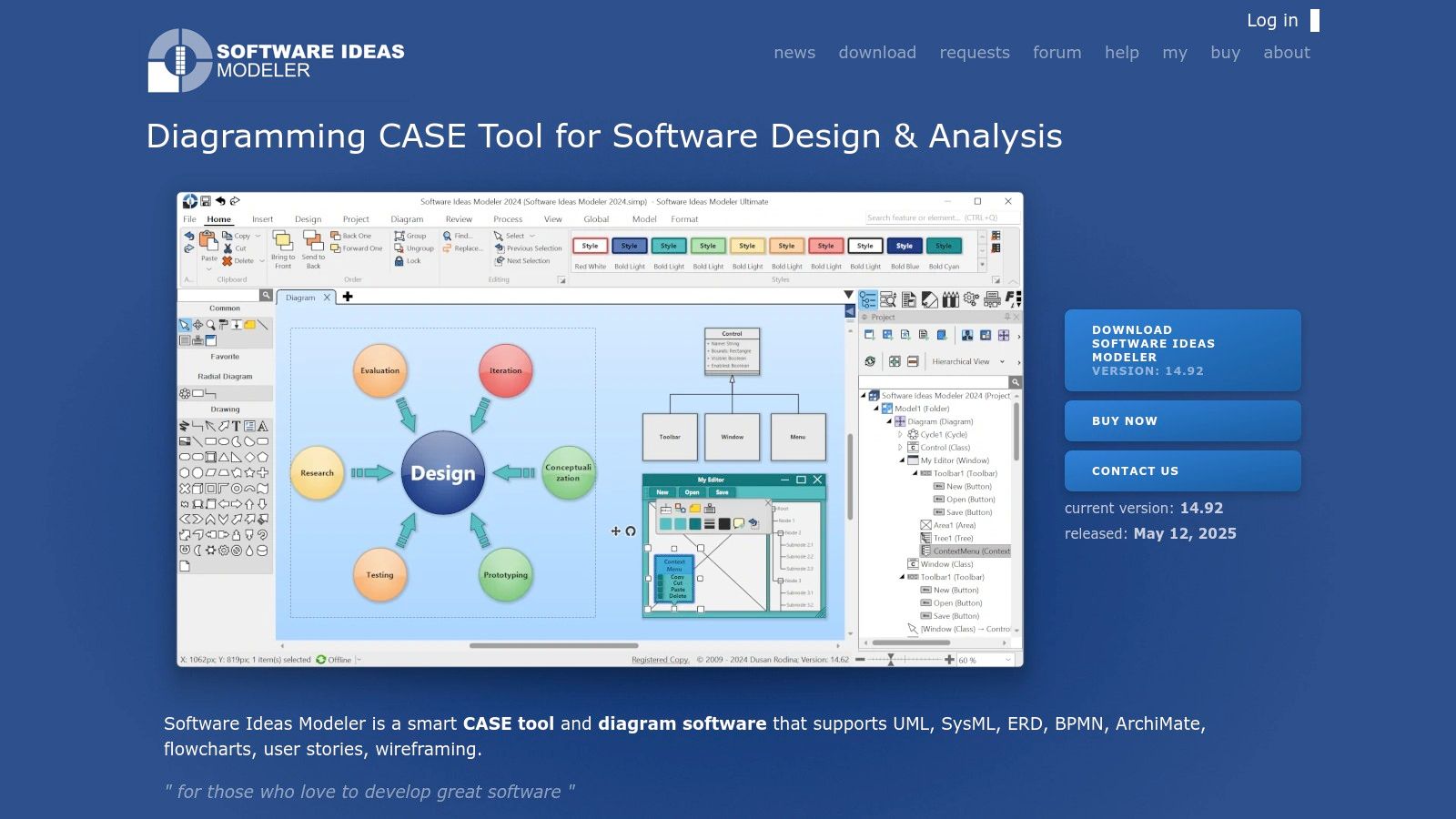
One of the key strengths of Software Ideas Modeler lies in its balance between a rich feature set and an intuitive user interface. While offering professional capabilities such as code generation (from models to code in languages like C#, Java, and SQL), reverse engineering (generating diagrams from existing code), and extensive documentation options, the interface remains user-friendly and easy to navigate. This is a significant advantage for teams looking to minimize the learning curve and quickly adopt a new software architecture visualization tool.
For practical application, consider a DevOps engineer tasked with visualizing the deployment architecture of a microservices-based application. Using Software Ideas Modeler, they can easily create deployment diagrams illustrating the relationships between different services, containers, and infrastructure components. Similarly, a data scientist could leverage the tool to create ERDs, outlining the structure and relationships within a complex dataset. The ability to generate code from diagrams also speeds up the development process, allowing developers to quickly create skeleton code based on the designed architecture.
Software Ideas Modeler offers a perpetual license model with various pricing tiers based on features and support levels. Technical requirements are relatively modest, with the software primarily running on Windows operating systems. While cross-platform support is limited, the comprehensive features and affordability make it a compelling alternative to more expensive enterprise-level tools like Enterprise Architect or IBM Rational Rhapsody.
Pros:
- More affordable: Offers a cost-effective solution compared to enterprise-grade alternatives.
- Intuitive interface: Easy to learn and use, minimizing the learning curve.
- Regular updates: Demonstrates active development and responsiveness to user needs.
- Comprehensive feature set: Specifically tailored for software architecture visualization.
Cons:
- Less widely adopted: Smaller community and fewer readily available resources compared to major competitors.
- Limited third-party integrations: May require workarounds for integrating with certain tools.
- Windows-focused: Limited cross-platform support.
- Smaller community: Less extensive support resources compared to more established tools.
Implementation Tip: Start with a simple diagram to familiarize yourself with the interface. Leverage the extensive documentation and tutorials available on the website to explore advanced features like code generation and reverse engineering.
Website: https://www.softwareideas.net/
Software Ideas Modeler deserves its place on this list due to its unique combination of affordability, a comprehensive feature set tailored for software architecture visualization, and an intuitive interface. While it may lack the widespread adoption of some competitors, its strengths make it a valuable tool for individuals and teams seeking a powerful yet accessible solution for their modeling and diagramming needs.
Software Architecture Visualization Tools Comparison
| Tool | Core Features/Highlights | User Experience & Quality ★★★★☆ | Value & Pricing 💰 | Target Audience 👥 | Unique Selling Points ✨ |
|---|---|---|---|---|---|
| Structurizr | C4 model, code+UI diagramming, multi-language | Consistent sync with code, flexible DSL | Free tier + paid enterprise 💰 | Developers, architects | Diagrams as code; enterprise self-hosting 🏆 |
| PlantUML | Text-based UML, many diagram types, IDE plugins | Strong community, version control friendly | Free & open source 💰 | Developers, doc writers | Plain text diagramming; broad integrations |
| Lucidchart | Cloud-based, real-time collaboration, templates | Drag-drop UI, multi-platform web app | Subscription-based 💰 | Teams, enterprises | Real-time collaboration; extensive integration |
| Visual Paradigm | UML + SysML, code generation, IDE integration | Powerful but complex, all-in-one tool | Higher cost 💰 | Developers & enterprises | Round-trip engineering; broad diagram support |
| Enterprise Architect | Multi-standard modeling, simulation, collaboration | Enterprise-grade, steep learning curve | Premium pricing 💰 | Large enterprises, architects | Extensive modeling; simulation & execution |
| draw.io (diagrams.net) | Free & open source, cloud storage integrations | Simple drag-drop, online/desktop | Completely free 💰 | All user levels, teams | No cost, versatile storage & export options |
| Mermaid JS | Markdown-style text diagrams, browser rendering | Lightweight, code-friendly | Free & open source 💰 | Developers, document writers | Markdown integration; dynamic browser rendering |
| Software Ideas Modeler | 30+ diagram types, code gen, reverse engineering | Balanced features, Windows-focused | More affordable than enterprise | SMEs, individual developers | Comprehensive UML focus; code & doc integration |
Architecting Your Future with the Perfect Visualization Tool
Choosing the right software architecture visualization tool is crucial for successful software development. From the simple elegance of PlantUML to the robust features of Enterprise Architect, and the versatile web-based solutions like Lucidchart and draw.io (diagrams.net), each tool offers a unique approach to visualizing your system's design. More specialized tools like Structurizr cater specifically to architecture diagrams, while options like Mermaid JS and Software Ideas Modeler offer unique functionalities for different needs. Key takeaways include considering your team's familiarity with certain languages (like Markdown for Mermaid JS) and the level of detail and collaboration required for your project. Software architecture visualization is crucial for effective communication and collaboration, especially in agile workflows where rapid iterations and constant communication are essential. This is highlighted in Unleashing Team Potential: Agile Meetings Redefined from resolution Reichert Network Solutions GmbH, which provides valuable insights into optimizing agile processes.
Implementing these software architecture visualization tools requires considering factors such as cost, integration with existing workflows, and the learning curve for your team. Select a tool that aligns with your project's complexity and your team's technical expertise. The most important aspect is to choose a tool that fosters clear communication and facilitates a shared understanding of the system's architecture amongst all stakeholders.
By carefully evaluating the tools mentioned in this listicle and considering your specific needs, you can empower your team to design, build, and maintain robust and scalable software systems. Now that you have a clearer picture of your software architecture, streamline your code preparation for LLM analysis with TreeSnap. TreeSnap helps you quickly and efficiently prepare code snippets for effective use with Large Language Models, freeing up your time to focus on the insights derived from your visualized architecture.